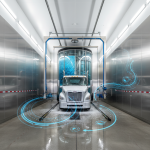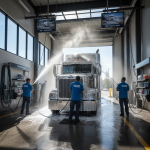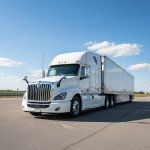In today’s fast-paced world, efficiency is key, especially when it comes to delivery services. Delivery vehicles play a crucial role in ensuring that goods reach their destinations in a timely manner. However, maintaining and cleaning these vehicles can be a time-consuming and resource-intensive task. That’s where automatic wash systems come in, revolutionizing the way delivery vehicles are cleaned.
Automatic wash systems are specially designed to streamline the last mile by efficiently removing dirt, grime, and other contaminants from delivery vehicles. These state-of-the-art systems offer a range of features, including advanced cleaning technologies and customizable wash cycles, ensuring that vehicles are thoroughly cleaned and sanitized.
By incorporating automatic wash systems into their operations, delivery companies can significantly reduce the time and effort required to clean their vehicles, allowing them to focus on their core business of delivering goods. Moreover, these systems are designed to be eco-friendly, minimizing water usage and reducing environmental impact.
In conclusion, the integration of automatic wash systems in the last mile of delivery services is a game-changer. It enhances efficiency, saves time, and ensures that delivery vehicles are in optimal condition. Stay tuned to discover more about the benefits and features of these innovative systems.
The importance of vehicle cleanliness in last mile delivery
Cleanliness is of utmost importance when it comes to last mile delivery. Delivery vehicles are constantly on the move, transporting goods from one location to another. As a result, they are exposed to various external factors that can lead to the accumulation of dirt, grime, and other contaminants. These contaminants not only make the vehicles appear unsightly but can also affect their performance and longevity.
Maintaining clean delivery vehicles is essential for several reasons. Firstly, a clean vehicle represents the professionalism and reliability of the delivery company. Customers are more likely to trust a company that takes pride in the appearance and cleanliness of its vehicles. Secondly, clean vehicles are less likely to encounter mechanical issues caused by dirt or debris, reducing the risk of breakdowns and delays in delivery. Lastly, clean vehicles contribute to a positive brand image, leaving a lasting impression on customers and potential clients.
Challenges in cleaning delivery vehicles manually
Traditionally, delivery vehicles have been cleaned manually, which can be a time-consuming and labor-intensive process. Cleaning a single vehicle can take hours, especially if it is heavily soiled. This manual approach often involves scrubbing, rinsing, and drying the vehicle using various cleaning agents and tools.
Manual cleaning also poses challenges in terms of consistency and effectiveness. Different individuals may clean the vehicles differently, resulting in varying levels of cleanliness. Moreover, manual cleaning may not always be able to remove stubborn stains or reach inaccessible areas, leaving the vehicle less than thoroughly cleaned.
Additionally, manual cleaning requires a significant amount of water, which can be wasteful and environmentally unfriendly. The excessive use of water not only contributes to increased water bills but also adds to the overall environmental impact of the delivery company.
The benefits of automatic wash systems for delivery vehicles
Automatic wash systems offer numerous benefits for cleaning delivery vehicles. These systems are designed to optimize the cleaning process, providing efficient and effective results. Here are some key benefits of using automatic wash systems for delivery vehicles:
1. Time-saving: Automatic wash systems can clean a vehicle in a fraction of the time it takes to clean it manually. These systems are equipped with advanced cleaning technologies, such as high-pressure jets and rotating brushes, that can quickly and thoroughly remove dirt and grime. As a result, delivery companies can save valuable time and allocate their resources more efficiently.
2. Consistency and quality: Automatic wash systems ensure consistent and high-quality cleaning results. The automated process eliminates human error and ensures that each vehicle is cleaned to the same standard. The use of advanced cleaning technologies also enables these systems to reach difficult-to-access areas, ensuring a thorough and comprehensive clean.
3. Water and resource efficiency: Automatic wash systems are designed to minimize water usage, making them more environmentally friendly and cost-effective. These systems utilize water recycling and reclamation techniques, reducing the amount of water needed for each wash. The use of eco-friendly cleaning agents further enhances the sustainability of these systems.
4. Customizable wash cycles: Automatic wash systems offer customizable wash cycles, allowing delivery companies to tailor the cleaning process to the specific needs of their vehicles. Whether it’s a quick rinse, a deep clean, or sanitization, these systems can be programmed to deliver the desired results. This flexibility ensures that each vehicle receives the appropriate level of cleaning.
How automatic wash systems work
Automatic wash systems employ a combination of advanced technologies to clean delivery vehicles efficiently. Here’s a breakdown of the typical process:
1. Pre-wash: The vehicle is pre-washed to remove loose dirt and debris. High-pressure jets, combined with specially formulated cleaning agents, help to soften and loosen stubborn stains.
2. Main wash: The vehicle enters the main wash area, where rotating brushes or high-pressure jets thoroughly clean the exterior surfaces. These cleaning elements are designed to remove tough dirt, grime, and contaminants while being gentle enough to protect the vehicle’s paintwork.
3. Rinse cycle: After the main wash, the vehicle goes through a rinse cycle to remove any remaining cleaning agents and residue. High-pressure jets or water curtains ensure that all surfaces are thoroughly rinsed.
4. Drying stage: Finally, the vehicle is dried using a combination of powerful blowers and air vents. This ensures that the vehicle is left clean, dry, and ready for the next delivery.
Automatic wash systems can be customized to include additional features such as undercarriage cleaning, wheel cleaning, and even touch-free systems that eliminate the need for brushes. These features further enhance the cleanliness and overall appearance of the vehicles.
Case studies: Companies using automatic wash systems for their delivery vehicles
Several prominent delivery companies have embraced automatic wash systems to streamline their vehicle cleaning processes. Let’s take a look at some of these case studies:
1. Company A: Company A, a leading e-commerce delivery service, implemented automatic wash systems across its fleet of delivery vehicles. By doing so, they were able to reduce vehicle cleaning time by 50% and reallocate resources to more critical tasks. The consistent cleaning results also improved their brand image, leading to increased customer satisfaction and loyalty.
2. Company B: Company B, a food delivery service, adopted automatic wash systems to maintain the cleanliness and hygiene of their delivery vehicles. The customizable wash cycles allowed them to meet the stringent sanitation standards required for food transportation. This implementation not only ensured the safety of their delivered goods but also enhanced their reputation as a reliable and responsible food delivery provider.
3. Company C: Company C, a pharmaceutical distribution company, integrated automatic wash systems into their vehicle cleaning process to meet the industry’s strict cleanliness requirements. These systems enabled them to thoroughly sanitize their vehicles, reducing the risk of contamination during the transportation of medical supplies. The company’s commitment to cleanliness and safety resonated with their clients and helped solidify their position as a trusted healthcare logistics provider.
Considerations when choosing an automatic wash system
When selecting an automatic wash system for delivery vehicles, several factors should be taken into consideration:
1. Capacity: Determine the number of vehicles that need to be cleaned within a given timeframe and choose a system that can handle the required capacity. Consider both the throughput and the efficiency of the system to ensure that it can meet the demands of your delivery operations.
2. Cleaning capabilities: Assess the specific cleaning needs of your vehicles. Consider whether the system offers customizable wash cycles, specialized cleaning agents, and features such as undercarriage cleaning or wheel cleaning. Ensure that the system can effectively remove the types of contaminants commonly encountered by your vehicles.
3. Water and resource efficiency: Look for systems that promote water conservation and sustainability. Consider features such as water recycling, reclamation, and the use of eco-friendly cleaning agents. Opting for a system that minimizes water and resource usage can help reduce operational costs and environmental impact.
4. Maintenance and support: Evaluate the maintenance requirements of the system, including routine cleaning, component replacements, and technical support. Choose a system that offers reliable customer support and has a reputation for durability and longevity.
5. Cost and ROI: Consider the upfront and ongoing costs associated with the system, including installation, maintenance, and potential upgrades. Evaluate the return on investment (ROI) based on the time and resource savings, improved efficiency, and enhanced brand image that the system can provide.
Cost and ROI of automatic wash systems
The cost of implementing an automatic wash system for delivery vehicles can vary depending on factors such as system capacity, features, and manufacturer. However, it is important to consider the long-term benefits and return on investment (ROI) that these systems can offer.
While the upfront costs may seem significant, the time and resource savings provided by automatic wash systems can generate substantial cost reductions over time. By streamlining the cleaning process, delivery companies can allocate their resources more efficiently, leading to increased productivity and profitability. Moreover, the improved brand image and customer satisfaction resulting from clean and well-maintained vehicles can lead to higher customer retention and new business opportunities.
Maintenance and upkeep of automatic wash systems
To ensure the optimal performance and longevity of automatic wash systems, regular maintenance and upkeep are essential. Here are some maintenance tips to consider:
1. Routine cleaning: Regularly clean the system’s components, including brushes, jets, and water collection areas, to remove any dirt or debris that may affect performance.
2. Inspect and replace components: Periodically inspect the system for signs of wear and tear. Replace any damaged or worn-out components to maintain optimal cleaning efficiency.
3. Water treatment and filtration: Implement water treatment and filtration systems to ensure the quality of the water used in the wash cycle. Regularly monitor and maintain these systems to prevent clogging or contamination.
4. Scheduled maintenance: Follow the manufacturer’s recommended maintenance schedule for the system. This may include lubrication, pump maintenance, and software updates.
5. Training and education: Provide training to the operators responsible for using the automatic wash system. Ensure that they understand the proper operation and maintenance procedures to maximize the system’s effectiveness.




